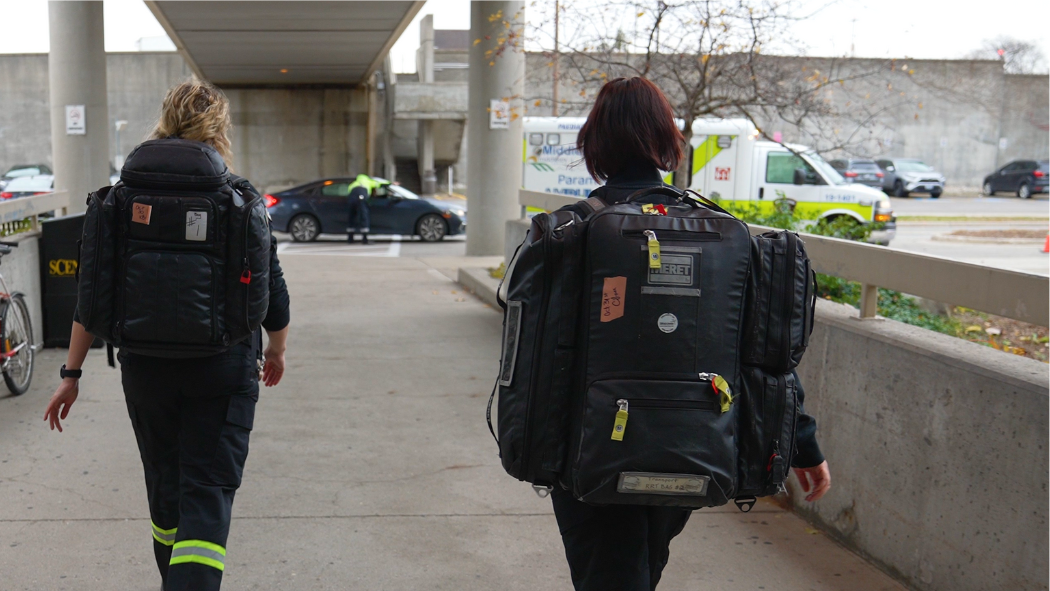
November 30, 2023
Any day, any time, the Neonatal Paediatric Transport Team could get the call.
“The call” is an ask for help from any of the dozens of regional partners who need this team and their specialized knowledge and equipment to help save a child’s life.
For over 30 years the Neonatal Paediatric Transport Team has been an important resource for kids who are too unstable to stay where they are, or for regular modes of transportation. With the largest geographic catchment area of all the neonatal paediatric transport teams in Ontario, the team covers all of Southwestern Ontario to the US/Canada border, northeast all the way to the Manitoba border and north as far as Fort Francis and Red Lake . This team of highly-skilled and trained nurses and respiratory therapists travel by air and land to stabilize kids as young as preterm infants to 17 years and bring them back to Children’s Hospital at London Health Sciences Centre (LHSC) for the level of care they need.
From January 2023 to date the team has taken approximately 900 calls. And respiratory season marks a particularly busy time: last year the team received almost double the call volume per day during the fall/early winter months. Due to the increased need the team is looking to expand to a third shift.
Who they are
A small but mighty team of 20 nurses and respiratory therapists make up this important resource. The team at Children’s Hospital are one of only four in the province, and ours was the first to transport children as old as 17.
As you can imagine, this requires an immense amount of knowledge and training: in fact, it takes approximately a year and a half of additional training before team members are certified as Provincially Certified Transport Clinicians. This training includes in-class learning, preceptor time and then transport-specific education and a series of provincially-mandated simulations. But one of the most important skill is the ability to pivot in an ever-changing situation.
"In the air, on the ground - anything can happen anywhere,” says, Leeann Trowbridge, Respiratory Therapist. “Luckily, we're skilled enough to be able to pivot as needed."
How they work
The initial call comes through CritiCall (an emergency consultation and referral service for physicians) from any hospital in their catchment area that need the support of the team to stabilize a patient, and then to get them to Children’s Hospital.
From there, the caller(s) will work with a physician to manage emergent needs, while the transport team determines what they will need to stabilize the patient and ensure they can be safely transported to Children’s Hospital.
The transport team then works with EMS partners, such as London Paramedic Services and ORNGE, to get to the patient by ground, fixed-wing aircraft, or helicopter. Physicians will sometimes attend these calls, but more often than not it’s just two team members: a nurse and a respiratory therapist.
While it can sometimes take hours to get there (with support from the team along the way), when they do arrive, Leeanne says, “we just get the warmest welcome. They’re so thankful we can help.”
The team then focuses on providing assessments and gathering additional information (particularly how things may have changed while they were traveling). They consult with Children’s Hospital physicians about next steps and prepare the patient for transport. This requires a number of specialized pieces of equipment, including their “mobile ICU”, which is a transport incubator generously donated through Children’s Health Foundation.
Patients are then transported to Children’s Hospital, providing care along the way as needed.
When asked about the team and their work, Director Dr. Henry Roukema praises their “superb” knowledge of transport medicine. “They know what needs to go right and what could go wrong in order to bring patients here safely."
Their role as educators
Another important part of the role is what the team calls “in-moment education”.
Once a patient is stabilized, the team often uses the opportunity to work with regional hospitals on education and pass along knowledge that could be helpful for future patient care.
But beyond the help and skills they bring to other hospitals, the team is also proud to support Children’s Hospital on-site as well.
“We have a lot to offer as a team,” explains Registered Nurse, Laura Regier. “We round to different units, we can help with advanced skills, we can even help facilitate transports within the hospital.”
Neonatal Paediatric Transport Team: Quick Facts
- One of only four neonatal paediatric transport teams in the province. The team at Children’s Hospital were the first to move beyond transporting only neonatal and very young patients, and instead pick up children as old as 17.
- The team works with EMS partners to transport children as young as preterm infants (up to 22 weeks) to 17 years of age who require intensive care via land and air.
- Their catchment area is as far north as Fort Francis, as far south as the Canada/US border, and through all of Southwestern Ontario.
- The team have received over 900 calls since January 2023.
- The team is comprised of 20 nurses and respiratory therapists, with one of each going on calls.